Media | Articles
“Fiero Jon” is the Pontiac mid-engine maestro
In his classic rock anthem Born to Run, New Jersey’s favorite son Bruce Springsteen romanticizes street racing in Asbury Park, New Jersey, with the lyric, “Sprung from cages out on Highway 9, chrome wheeled, fuel injected and steppin’ out over the line.”
“Highway 9” is U.S. Route 9 and is called Main Street in many of the small towns it passes through as it heads southward. Driving it about 50 miles south from Asbury Park lands you in Tuckerton, a bayside community of about 3500 founded more than 300 years ago by Ebenezer Tucker. There may not be a Springsteen song in that, but if The Boss ever feels inspired to write a tune about the 1984-1988 Pontiac Fiero (and why shouldn’t he?), he needs to make the trip and visit “Fiero Jon.”
Fiero Jon is the Pontiac superhero identity of Jon Miller. His recently expanded, 10-bay auto service shop, Jon Miller Car Care Center, usually has a few Fieros parked outside among the modern Chevys, Hondas, Fords, Nissans, Ram pickups and many others. None of those would be there, however, if not for the Fieros.
Miller entered the Fiero world quite by happenstance when he received a well-worn, high-mile 1986 SE model on his 17th birthday from his grandmother, Evelyn Miller. The teen couldn’t predict that the gift would kick off a passion, a career, and a thriving business. What he definitely could not have foreseen is that he’d become a much-needed resource for Fiero owners. Among the hundreds of collectors and enthusiasts Miller has helped over the years is noted car collector Ken Lingenfelter, who bought a pair of the plastic Ponchos from him earlier this year.

Mid-engine “commuter car”
Introduced for 1984, the Pontiac Fiero was America’s first mid-engine production car, beating the Corvette by 36 years. The name means “proud” in Italian, but the original vision for this affordable mid-engine sports car was diluted into more of a commuter car to win GM’s approval for production. Fiero’s engineering and design were daring, but a too-tight development budget forced parts-bin compromises.
Marketplace
Buy and sell classics with confidence
With a $7999 base price for a stripper model, the 1984 Fiero attracted many young customers for whom the semi-exotic design was reason enough to buy. Engineered to keep production costs low, the Fiero’s steel spaceframe construction with detachable plastic body panels also helped earn it a five-star federal safety rating. The Fiero’s modest mechanical bits came from other GM cars, including front suspension from the Chevy Chevette. For rear suspension, Pontiac adapted the front-wheel-drive Chevy Citation’s front suspension, anchoring the unneeded tie rods to the engine cradle. The 1984 Fiero came only with the 92-horsepower “Tech IV,” a generous rebranding of Pontiac’s low-tech Iron Duke 2.5-liter four-cylinder. Performance was tepid, but fuel economy was solid. (Today, the 50-mpg highway rating would roughly translate to a still-respectable 33 mpg under the current EPA testing standards.)
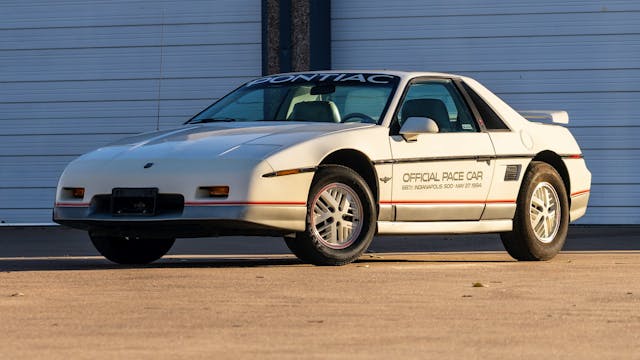
A highly modified Fiero served as the Official Pace Car of the 1984 Indianapolis 500, and Car and Driver put the Fiero on its 10 Best list. The magazine said: “What it is not is a killer sports car, but the Fiero is peppy in town, handles securely, sticks very well in the corners, and offers a spacious and comfortable environment that suits most any driver.”
After the honeymoon
First-year Fiero production approached 137,000, which made it a certifiable hit. And then came criticisms, including a stiff ride, lack of available power steering and lackluster quality. Worse, the Fiero suffered numerous engine failures and fires, with some cars destroyed.
For one thing, an error in the owner’s manual and all factory service materials, along with an incorrectly marked dipstick, indicated a three-quart oil capacity rather than the correct four quarts, with predictable results. (Previously published reports of the four-cylinder Fiero using a three-quart oil pan are incorrect.) Some Fieros also had faulty connecting rods that would break, wrecking engines and starting fires. A later recall replaced engines in 1984 Fieros, and Pontiac sent corrected service instructions to owners.
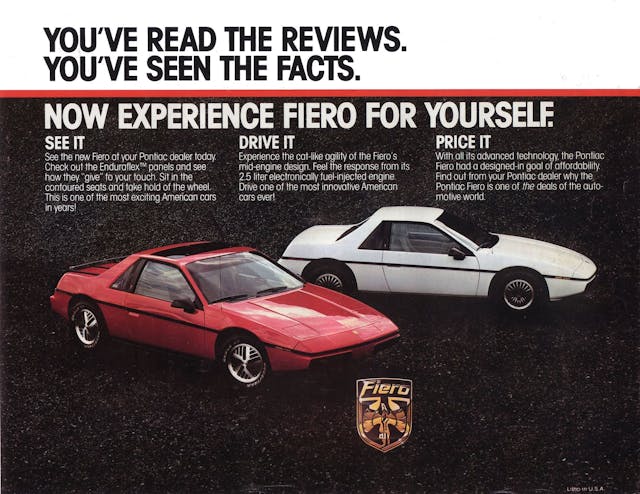
Sales took a hit, and Fiero production dropped to just over 76,000 for 1985. That was despite the addition of GM’s 60-degree 2.8-liter V-6 as a second engine choice, which significantly woke up performance. For 1986, the Fiero GT, which used only the V-6, got its own sexy fastback body style, and a five-speed manual was offered for both engines. Production crept back up to 84,000. That was still a solid number for a niche mid-engine two-seater.
A T-top option arrived for 1987, but production fell below 57,000. For 1988, the Fiero finally got the coilover suspension that had been planned from the start. A Formula option package installed the V-6 and other performance hardware on the standard Fiero coupe body for a big discount from the GT’s $14,000 price. The improvements came too late, though. Just over 26,400 Fieros were made in 1988, its final year. Altogether, Pontiac built about 370,000 examples.
Accidental Fiero guru
Receiving his grandmother’s Fiero was a windfall of sorts, but without the money to fix the car’s myriad mechanical issues, Miller had to learn to do the work himself. (At that point, he was just plain old “Jon.”) He’d had some “training” years before, helping his father, a school teacher, maintain the family’s 1965 six-cylinder Mustang convertible, but he was at this point a Fiero novice.

Miller scoured South Jersey scrapyards for Fiero parts and began meeting other owners. After he’d replaced the water pump in a friend’s Fiero, word-of-mouth brought more customers. He next bought a clean Fiero missing its engine from a scrapyard for $150. He stripped it to learn how it was put together and sold the usable parts on eBay, which was then in its infancy. Happily surprised after earning $1200 from those sales in just a few weeks, Miller, who was still in high school, could suddenly see a career path taking shape.
“I made a decision that I would never get a job,” he says. “I was going to become a Fiero specialist. I spent the next 13 years working solely on Fieros and also flipping them. I went to Carlisle and local Fiero shows religiously.”
From eBay to Main Street
Miller eventually opened a shop on Rt. 9 in Tuckerton, New Jersey, focusing on Fieros and later adding DeLoreans to his repertoire. Not wanting to bet his future entirely on cultish 1980s two-seaters, Miller began servicing other vehicles. He became ASE-certified and hired ASE-certified techs. He also earned a Bachelor of Science degree in Business Management from nearby Richard Stockton College. Miller’s business grew from a reputation for honest, quality work. In recent years, his work on Fieros has shifted mainly toward restoration, as most owners had retired their cars from daily driving.
“I’d say that 90 percent of Fieros I service are restored or are being restored,” he says. “The other 10 percent are still used as daily drivers, but that number is dwindling.”
Fiero owner demographics run the gamut.
“I have owners who are 70 and 80 who have been in the Fiero scene since 1984,” Miller explains. “I see them at Carlisle year after year until they die, and then we have memorials for them at the shows. I also see young kids—17, 18—who might find a Fiero behind somebody’s house for $300 and want to get it on the road.”

The majority of Fiero owners, he adds, are Gen X-ers acting on nostalgic feelings.
“This is the car they had, or always wanted, in high school. Some bought a Fiero brand new, still own it and have deep affection for it. That’s the customer who comes to me and says, ‘I want my car like brand new again.’”
One of those customers, identified as “Pete,” fits that mold.
“Pete has a 1984 base Fiero, red with the black trim and steel wheels,” says Miller. “I’ve been in the car with him. The only thing he listens to is ’80s music on cassettes. He tells me, ‘When I’m in my car, I’m in the ’80s, and that’s where I want to be.’”
Fieros are available inexpensively, with good GTs going for under $10,000. Many Fieros are available for far less. Restoring one costs more than the car is worth, but Miller says owners are not in it for the money.
A fitting tribute
In 2003, Miller began to restore the Fiero that launched his career. As a tribute to his grandmother, he wanted the car she had given him to showcase all that he loved and had learned about the Fiero.
What started as an SE now wears a GT body and has more power from a swap to the 2.8-liter engine’s more powerful 3.4-liter sibling. That larger engine was used in many GM cars in the 1980s and 1990s, but not the Fiero. The conversion to the GT’s fastback design required the entire rear clip, front bumper, plus the wiring harness, headliner, quarter windows, taillights and other odds and ends. Miller used NOS parts or parts taken from ultra-low mile donor cars. The custom metallic gold paint with black stripes is complemented by a Beachwood interior, which was a rare 1988-only option.
“There are over 900 hours in the paint job alone,” Miller says, adding that his labor of love cost more than $50,000. He’s not concerned about the car’s cost or value, though. “Because it was never going to be for sale, there was no way I could go upside down,” he says.
Sadly, Miller’s grandmother, Evelyn, passed away before he debuted the custom Fiero at the 2007 GM Nationals at Carlisle.
“It took four trophies including Best of Show,” he proudly recalls. “It has since taken first place in Modified Fastback every year it has competed at Carlisle, and Best of Show five times.”
From commuter to beast
Many Fiero owners take advantage of the car’s large engine bay to host a variety of swaps, including the Buick 3800 Supercharged, Chevy LS motors, and even Cadillac Northstars. The 3.4 V-6 in Miller’s car, though, shares the same block as the original 2.8 and is a factory-perfect fit. It’s the only Fiero engine swap Miller offers in his shop.
“It’s reliable and gives spirited performance, and it looks like the factory put it there,” he says. “With some mods like a mild cam and flat-top pistons, it’s easy to get 180 horsepower. There are no wiring changes. I just need to re-do an A/C bracket and move the starter to the other side. I’ve done some 3.4 turbos, too.”

Keeping Fieros alive
Fieros shared powertrains and other parts with other GM cars, but there are many specialized parts, along with problems that are unique to the two-seat Pontiacs.
“We’ve solved a lot of issues, but as the cars get older, new problems crop up,” says Miller, who is one of a small number Fiero specialists around the country.
The Fiero’s body panels are made from various plastics, but the space frame and other parts are steel, and rust can be a significant problem. Areas to check are the battery tray and the sheetmetal beneath it. The subframe (engine cradle) rusts out in the spot under that. The rear inner fender wells are a major rust area, and Miller says many owners don’t even know.
“I can fix a lot of the problems, but not a car that is rotting out. It’s just not cost effective. Sometimes I have to tell a customer that the car is finished,” Miller says. “When anyone brings a Fiero to me, that’s the first thing I look at,” he explains. “You have to remove the trunk carpeting and inspect the sidewalls of the trunk and the inner fender wells. If you’re still driving a Fiero, especially in the Northeast, every fall you need to remove the plastic wheelwells and wire-brush and paint those fender wells.”
In front, the radiator supports are rust-prone. Among mechanical maladies, high heat in the Fiero’s engine compartment, caused by inadequate airflow, leads to ignition module failures.
“Some people carry an extra module in the car,” Miller says, “but the cheap modules on the market fail quickly. I recommend getting the Delphi module.”

Sourcing Fiero parts
“The Fiero parts situation is better than you might think, but there are some unicorns,” Miller cautions. Rear brake calipers for all years make that list, and the ’88 Fiero poses a lot of its own challenges.
“The ’88 Fiero has its own braking system, and as far as getting rebuild kits to fix rear calipers, forget it. You have to take the car off the road.”
Miller cites the Fiero Store in Manchester, Connecticut, as a good source for Fiero parts. Among those are reproduction 1986-1988 GT taillights made by Keith Goodyear, along with quarter windows. If you want original GT taillights for those years, you’ll pay a lot.
“I used to get $1,000 for a set when I could find them,” says Miller.
He also offers high praise for Rodney Dickman for solving some vexing Fiero issues. Dickman makes specialized tools for some Fiero repair jobs, and to fix a problem with the popup headlight motors, he has put together a new replacement system.
Which Fiero is a fit for you?

Because of its refined suspension and handling, the 1988 Fiero is often singled out as the best one to buy, but Miller offers a different perspective.
“People say they want an ’88 GT. I say, good luck if you hit a curb and bend a control arm. You can’t get them, and you can’t get steering knuckles,” either.
He explains that you can buy a 1986-1987 Fiero GT and get the same look and performance for a lower price, and then upgrade its more easily sourced suspension for improved handling.
“Don’t count out the earlier cars,” Miller says. “There’s nothing wrong with an ’87 GT, and it’s cheaper to buy. But they’re all cheap to buy. Fieros are very undervalued, in my opinion.”
Of course, Fieros might not be undervalued for long if a certain Jersey rocker would write a song about them.
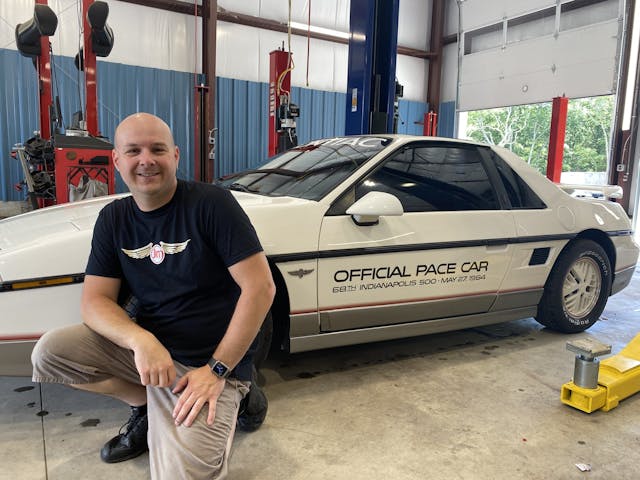








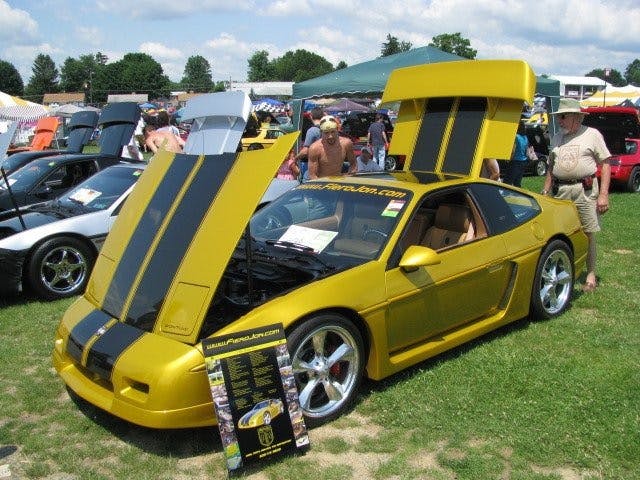
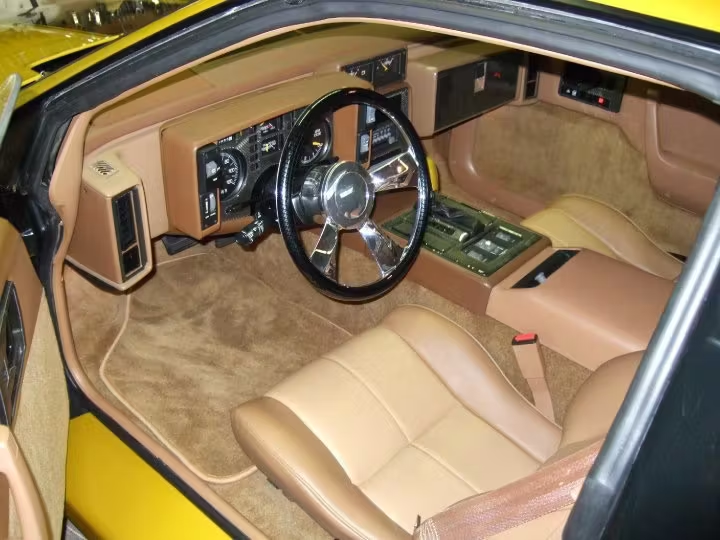









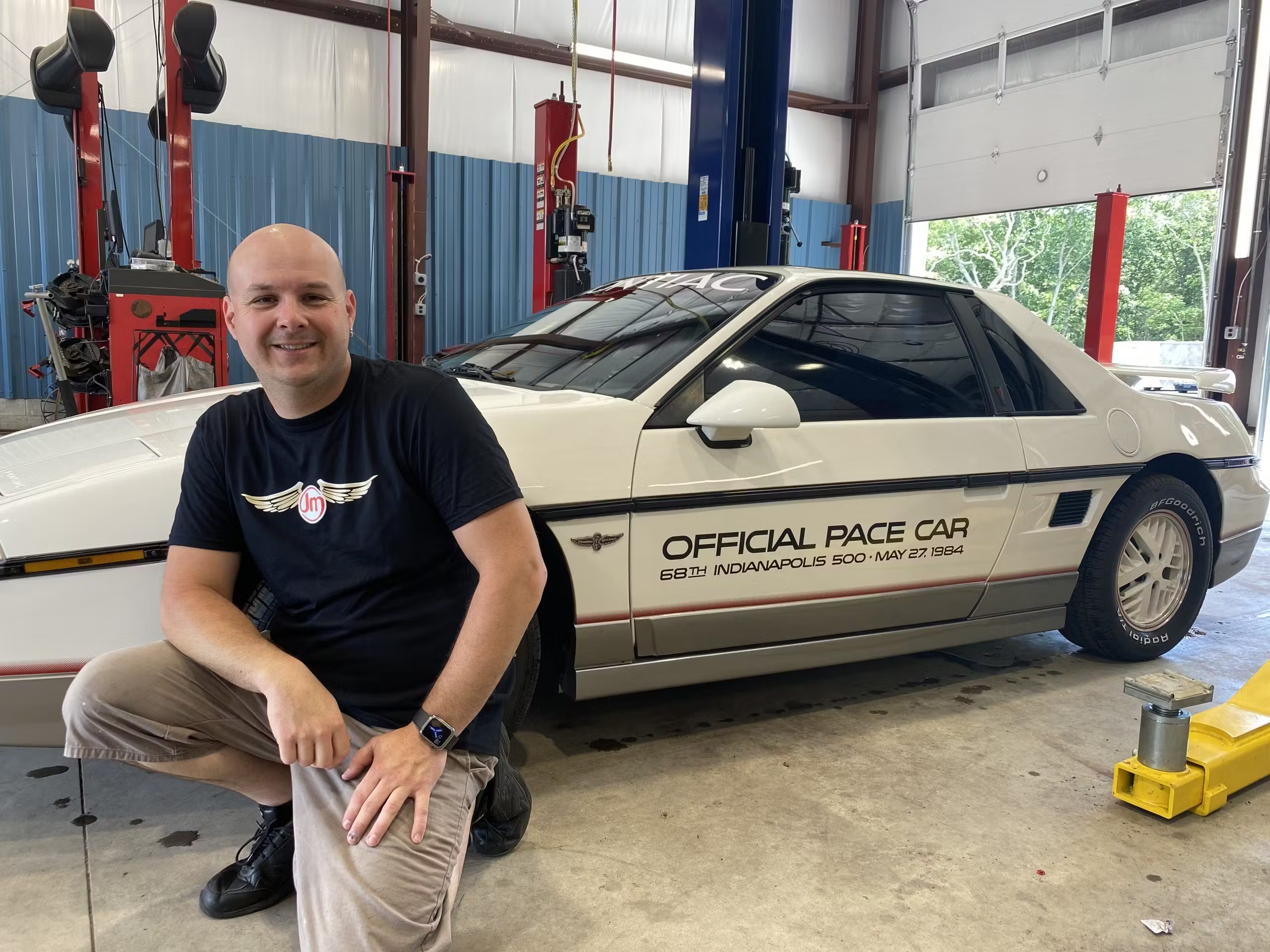
Excellent Article…
Google “fiero jet car”. It is still available at a very reduced price.
I have a 1984 4-cylinder, manual 4 shift transmission Fiero that needs a new engine. I am wanting to replace the engine with a 6-cylinder or 8-cylinder and am wondering if installing the 3.4 V-6 would require a lot of electrical wiring and other component changes.
I have an “88 formula that WAS previously owned by a girl that thought she needed a sports car but didn’t know how to drive or fix it. Lots of things wrong, any now it is new original( mechanically ). Now when it is started it runs great until it warms up, then one injector bank quits working. Any ideas???????
We have an original (I bought new) 1984 Indy Fiero (white) that my wife now wants to sell. Has about 55,000 miles on it. In great condition, and literally used by a very careful school teacher all those years! Can provide photos and more, if you send me your e-mail address.
Just purchased this exact Indy gem. Many thanks to Jon Miller. Would not have been possible without his help.
Fiero’s were unsafe junk. Riddled with problems and way too small. They will never be cool, they will never be fast. These are for people who can’t handle real race cars.
Greg, did you crash yours? Did it get stolen? No need to trash something others find enjoyment in. I have owned my Fiero GT for 38 years. I passed my driver’s test in it. I now run it every summer along with my two Corvettes. Yes, it’s still a fast little thing.